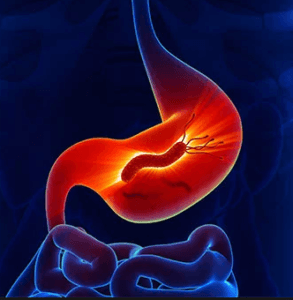In this issue of Gut Speak, here is dealing with the common term you’ve heard- but not fully aware of- Helicobacter Pylori. If you thought peptic ulcers in stomach and duodenum are mostly due to stress, improper diet pattern, NSAID (pain medications), smoking and alcohol, well, there is one other very important cause- a bacteria called Helicobacter Pylori. World Health Organisation (WHO) has listed H pylori as a class I human carcinogen (cancer producing potential) which highlights the potential of this bacteria to cause long term human colonisation and its ability to cause stomach and duodenal ulcers and cancer.
History:
Helicobacter pylori was first discovered in the stomachs of patients with gastritis and stomach ulcers in 1982 by Dr. Barry Marshall and Dr. Robin Warren of Perth, Western Australia. At the time, the conventional thinking was that no bacterium can live in the human stomach, as the stomach produced extensive amounts of acid of a strength similar to the acid found in a car battery. Marshall and Warren rewrote the textbooks with reference to what causes gastritis and gastric ulcers. In recognition of their discovery, they were awarded the 2005 Nobel Prize in Physiology or Medicine.
Although there was some scepticism initially, within several years numerous research groups verified the association of H. pylori with gastritis and, to a lesser extent, ulcers. To demonstrate H. pylori caused gastritis and was not merely a bystander, Marshall drank a beaker of H. pylori culture. He became ill with nausea and vomiting several days later. An endoscopy ten days after inoculation revealed signs of gastritis and the presence of H. pylori. These results suggested H. pylori was the causative agent of gastritis. Marshall and Warren went on to demonstrate that antibiotics are effective in the treatment of many cases of gastritis.
Prevalence:
At least half the world’s population are infected by the bacterium, making it the most widespread infection in the world. Infection is more prevalent in developing countries, and the incidence is decreasing in Western countries. H. pylori’s helix shape (from which the generic name is derived) is thought to have evolved to penetrate the mucoid (acid protective) lining of the stomach.
Transmisssion:
The most common route of H pylori infection is either oral-to-oral or faecal-to-oral contact. Consistent with these transmission routes, the bacteria have been isolated from faeces, saliva and dental plaque of some infected people. H. pylori is probably spread by consuming food or water contaminated with faecal matter. Transmission occurs mainly within families in developed nations yet can also be acquired from the community in developing countries. H. pylori may also be transmitted orally by means of fecal matter through the ingestion of contaminated water, so a hygienic environment could help decrease the risk of H. pylori infection.

Signs and symptoms:
In general, patients infected with H pylori are asymptomatic, and no specific clinical signs have been described. When signs and/or symptoms are present, they may include the following non specific symptoms like:
- Nausea
- Vomiting
- Abdominal pain
- Heartburn
- Bloating
- Diarrhoea
- Hunger in the morning
- Halitosis (bad breath)
Bacterial colonisation:
To colonize the stomach, H. pylori must survive the acidic pH of the stomach and use its flagella (long thread like structures) to burrow into the mucus to reach its niche, close to the stomach’s epithelial (lining) cell layer. To avoid being carried into the lumen, H. pylori senses the pH gradient within the mucus layer and swims away from the acidic contents of the lumen towards the more neutral pH environment of the epithelial cell surface. H. pylori produces large amounts of the enzyme urease, molecules of which are localized inside and outside of the bacterium. Urease breaks down urea (which is normally secreted into the stomach) to carbon dioxide and ammonia. The ammonia is converted to ammonium by accepting a proton (H+), which neutralizes gastric acid. The survival of H. pylori in the acidic stomach is dependent on urease. The ammonia produced is toxic to the epithelial cells of stomach. Colonization of the stomach by H. pylori results in chronic gastritis, an inflammation of the stomach lining. The severity of the inflammation is likely to underlie H. pylori-related diseases. Duodenal and stomach ulcers result when the consequences of inflammation allow the acid and pepsin in the stomach lumen to overwhelm the mechanisms that protect the stomach and duodenal mucosa from these caustic substances. The type of ulcer that develops depends on the location of chronic gastritis, which occurs at the site of H. pylori colonization.
Pic courtesy: cinfasalud.com
